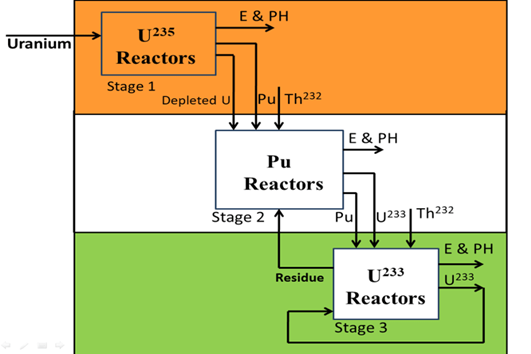NUCLEAR ENERGY
Published on 17 Feb 2025
Nuclear power generates electricity through nuclear reactions, primarily the fission of uranium and plutonium in power plants. The energy from controlled fission heats water into steam, which drives turbines connected to generators.
Benefits of nuclear energy
✔ Energy Sovereignty: Fossil fuels supplied 82% of India's energy in 2021, with imports raising risks. Nuclear energy can reduce this reliance.
✔ Decarbonisation: Nuclear power lowers the power sector's carbon footprint, aiding in climate mitigation.
✔ Limitations of Renewables: Solar and wind are land-intensive, require storage, and rely on imported technology, while nuclear energy reduces import dependency.
✔ Operational Costs: Nuclear plants are 33-50% cheaper to operate than coal plants and 20-25% cheaper than gas plants.
✔ Reliability: Nuclear power provides consistent base load energy, unlike intermittent solar and wind.
✔ Resource Base: India has ample thorium reserves in coastal monazite sands, viable for thermal breeder reactors.
✔ National Security: Nuclear research has bolstered India's defence capabilities and deterrence, particularly in regional conflicts.
India's 3-stage nuclear program
✔ Formulation: Homi Bhabha in the 1950s, aims to achieve long-term energy security using the country's uranium and vast thorium reserves.
✔ Stage I: Pressurised Heavy Water Reactors (PHWRs) use natural uranium (U-238) as fuel to produce energy and plutonium-239 (Pu-239).
✔ Stage II: It involves using Pu-239 and U-238 in Fast Breeder Reactors (FBRs) to generate more energy, U-233, and additional Pu-239.
✔ Stage III: It focuses on advanced nuclear power systems that utilize thorium-232 (Th-232) and Pu-239 to produce energy and U-233.
✔ Thorium Reserve: This program leverages India's significant thorium reserves, positioning the country towards complete self-sufficiency in nuclear energy.

Fast Breeder Reactor (FBR) Programme in India
FBR programme is part of its strategy to enhance nuclear energy production by utilizing fast neutron reactors to generate more fissile material than they consume.
Key Features:
✔ Fast Neutron Reactors: Utilize fast neutrons to sustain the nuclear fission process and convert fertile material into fissile material.
✔ Fuel Cycle: Employs a closed fuel cycle, where spent fuel is reprocessed to extract plutonium, which is then used in new fuel assemblies.
✔ Sustainability: Designed to maximize the use of uranium resources and enhance energy security by breeding more fuel than consumed.
✔ Prototype Fast Breeder Reactor (PFBR): The first commercial-scale FBR being constructed in India to demonstrate the viability of the technology.
● Example: Located at Kalpakkam, Tamil Nadu, and expected to play a critical role in India's nuclear energy strategy.
Challenges of nuclear energy
✔ Nuclear Disaster: Radioactive fission can cause fatal leaks and defects
● Example: Chernobyl (1986) and Fukushima (2011) disasters.
✔ Availability of Cheap Alternatives: Solar and wind energy are cheaper, at INR 2-4 per unit, compared to nuclear energy’s INR 9-12 per unit.
✔ Inadequate Foreign Research: India’s civil liability law and lack of membership in the Nuclear Supplier Group and the Non-Proliferation Treaty limit foreign technology access.
✔ Capital Intensive: Nuclear power plants require a high initial investment.
✔ Insufficient Capacity: India’s nuclear capacity is 6.78 GW, well short of the 650 GW goal for 2050.
✔ Nuclear Safety: Local protests, like those against driven by fears of disasters.
● Example: Protest in Kudankulam and Mithivirdi.
✔ Nuclear Liability: The Civil Liability for Nuclear Damage Act 2010 has discouraged foreign suppliers due to liability concerns.
✔ Outdated Technology: Indian reactors, including designed at Kudankulam, face issues due to outdated technology.
Govt initiatives and institutions for nuclear energy development
✔ Tata Institute of Fundamental Research (TIFR) (1945): Established by Homi J. Bhabha for advanced research in fundamental sciences, including nuclear physics.
✔ Atomic Energy Commission of India (AEC) (1948): Formulated and managed India’s nuclear policy and technology development.
✔ Department of Atomic Energy (DAE) (1954): Promoted nuclear power generation and radiation applications in various fields.
✔ Nuclear Power Grid Connection (1969): Integrated Tarapur Plant’s electricity into India’s national grid.
✔ Smiling Buddha Nuclear Test (1974): India’s first nuclear test, resulting in international condemnation and fuel supply restrictions.
✔ Nuclear Power Corporation of India Limited (1987): Manages and operates India’s nuclear power plants for electricity generation.
✔ BHAVINI (2003): Focuses on implementing the second phase of India’s three-stage nuclear power program.
Way forward
✔ Small Modular Reactors (SMRs): Build indigenous SMRs at retiring coal sites; explore partnerships with NTPC and other plant owners.
● Example: NuScale Power SMR in the U.S. is designed for deployment at existing nuclear and coal plant sites.
✔ Expansion of PHWRs: Increase the fleet of 700 MWe PHWRs to boost nuclear capacity.
● Example: Canada's CANDU reactors, similar to PHWRs, have been expanded to enhance nuclear generation.
✔ Push to Stage-3 Nuclear Program: Advance the second and third stages of India's nuclear program to utilize thorium resources.
● Example: The Advanced Heavy Water Reactor (AHWR) aims to utilize thorium as part of India's third-stage program.
✔ Development of Nuclear Fusion: Explore nuclear fusion technology, benefiting from India’s ocean water reserves.
● Example: The ITER reactor in France is a major international project to demonstrate nuclear fusion’s potential.
✔ Augmentation of Safety: Update nuclear operators' safety skills and educate the public.
● Example: Dr. APJ Abdul Kalam’s public education efforts were crucial before establishing the Kudankulam plant.
✔ Ensuring Regulatory Autonomy: Provide the Atomic Energy Regulatory Board (AERB) with functional autonomy from the Department of Atomic Energy.
● Example: The Nuclear Regulatory Commission (NRC) in the U.S. operates independently from the Department of Energy for unbiased oversight.